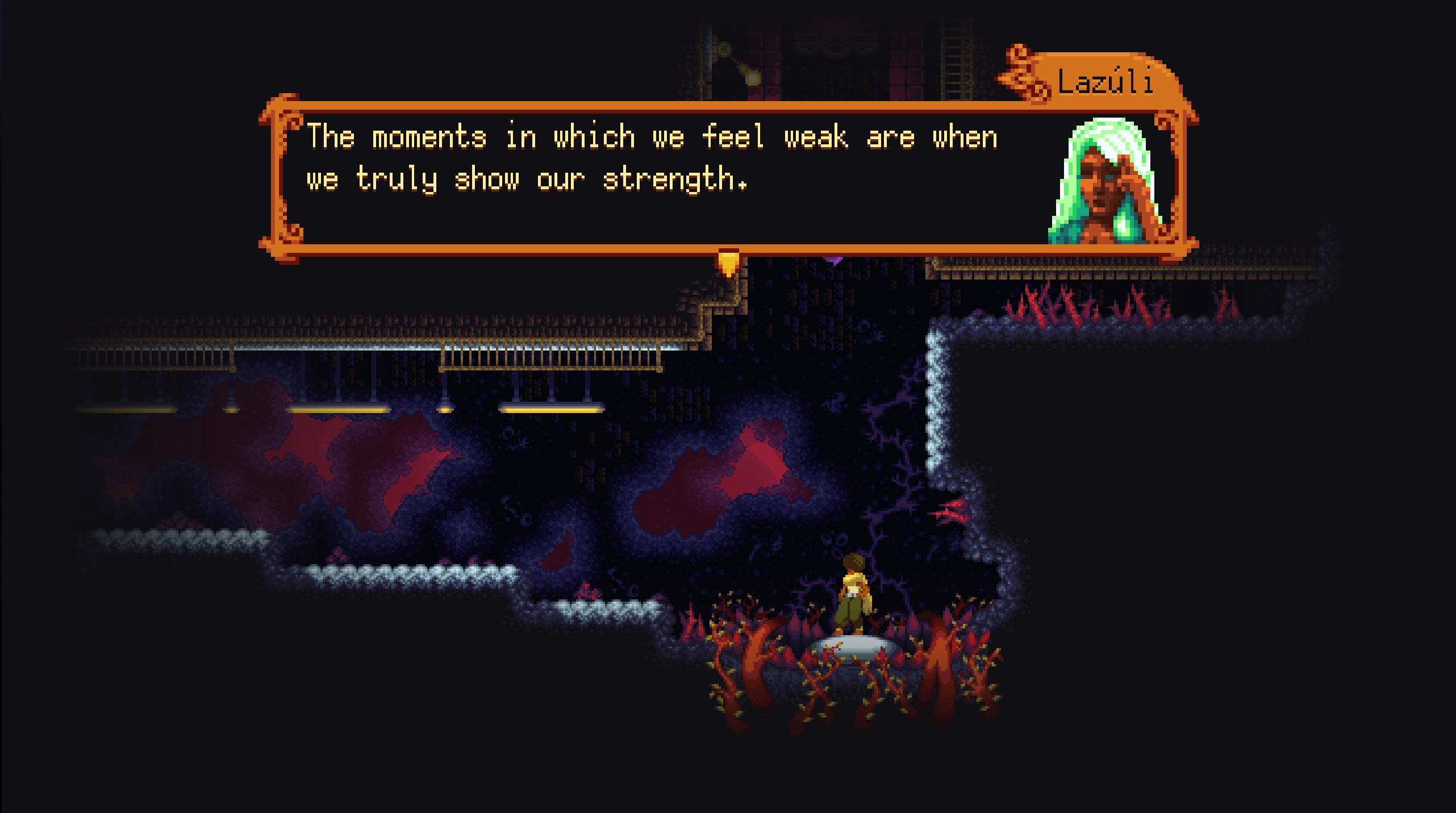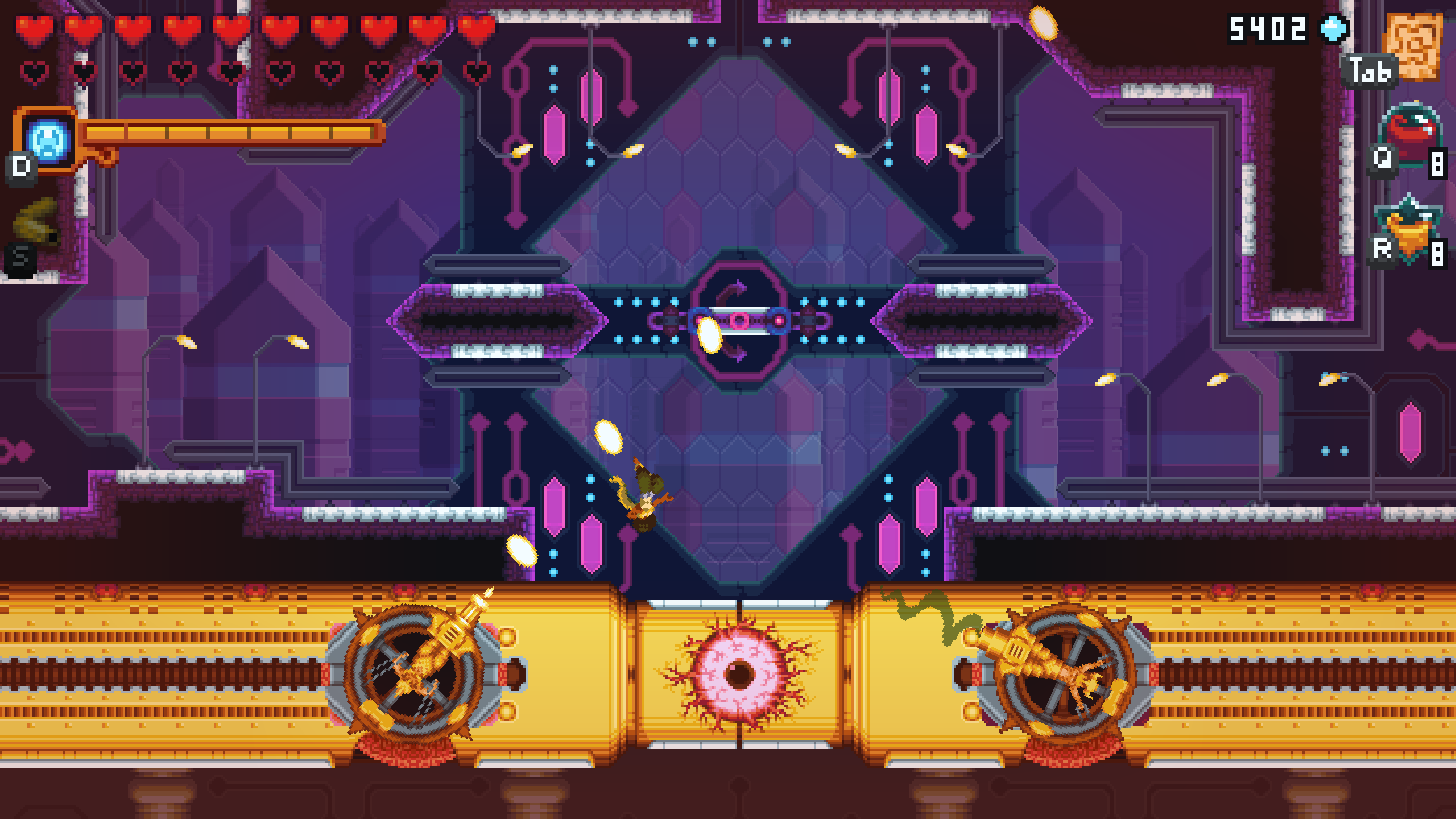Search
[{{{type}}}] {{{reason}}}
{{/data.error.root_cause}}{{{_source.title}}} {{#_source.showPrice}} {{{_source.displayPrice}}} {{/_source.showPrice}}
{{#_source.showLink}} {{/_source.showLink}} {{#_source.showDate}}{{{_source.displayDate}}}
{{/_source.showDate}}{{{_source.description}}}
{{#_source.additionalInfo}}{{#_source.additionalFields}} {{#title}} {{{label}}}: {{{title}}} {{/title}} {{/_source.additionalFields}}
{{/_source.additionalInfo}}- Details
- Category: Computer
- By Cinque Pierre
- Hits: 2429
Dandara: Trials of Fear Edition (PC)

Dandara: Trials of Fear Edition
Developed By: Long Hat House
Published By: Raw Fury
Released: February 6, 2018 (Trials of Fear Edition: March 6, 2020)
Available On: Android, iOS, Linux, macOS, PlayStation 4, Windows, Switch, Xbox One
Genre: Platformer
ESRB Rating: E10 – Everyone 10+: Fantasy Violence, Language
Number of Players: Single player
Price: $14.99
(Humble Store Link)
Thank you Raw Fury for sending us a review code!
Dandara is a rather interesting game in many ways. For one, the title of the game and the name of the character is taken from the one living person, Dandara. She was an Afro-Brazilian warrior who lived in Brazil during the colonial period and fought for the freedom of the slaves during the 17th century. She was eventually captured but instead of living the life of a slave, she found solace in death and committed suicide. Due to the nature of Brazil in that time frame, the recorded tales of Dandara tend to vary greatly.
Long Hat Games, being Brazilian developers, take great inspiration from Brazilian culture and implement it into their creation. The titular character even shares traits with the real Dandara—being a skilled warrior who fights for the oppressed individuals of Salt. With areas looking like the urban streets you would see in the country, with street lamps and graffiti littered throughout, to temple-like areas that blend a futuristic aesthetic, Long Hat Games does a wonderful job showing off the rich and vibrant culture of Brazil. I enjoyed the choice of having the earlier sections brimming with life and a sense of freedom of expression. Many of the handful of characters within Salt you'll see within the first two sections, with the last sections of the game having said characters being entirely absent. The totalitarian state that represents the later half of Salt gives off a dire situation, with many of the enemies, in particular, being held against their will.
The other aspect that makes Dandara so interesting is that the world of Salt has no gravity, and the devs take advantage of this by having a rather innovative movement system for a Metroidvania. Most Metroidvanias are 2D platformers that have a traditional movement system with a focus on exploration, with very few of them being 3D. While Dandara is of the 2D Metroidvania variety in both concept and execution, it also scraps the traditional movement in favor of something different. For Dandara to move, she must leap from point to point instead, with places that she is able to jump to coated with a white layer on top.

Strong Points: Boss battles show off the strengths of the movement and combat system; the setting is truly one of a kind
Weak Points: Controls were made with a touchscreen in mind, so other control methods suffer ; navigation can be a bit confusing and takes some time to get used to
Moral Warnings: The world of Salt Is magical in nature, so there are a lot of supernatural elements; general violence with enemies exploding; one instance of the world “b*st*rd” uttered
Dandara’s main method of attacking is by shooting arrows of light and aiming feels similar to a twin-stick shooter, but without the usage of the second stick. Further in the game, Dandara can gain other abilities such as missiles and lasers to mix up her arsenal. Movement in itself is snappy, fluid and responsive with combat complementing the experience, but it is clear as day to anyone playing that Dandara’s movement was not made with a traditional controller in mind. As Long Hat Games started off as mobile developers, Dandara fits best on Android or iOS devices. It controls fine with a gamepad with the combination of using the control stick and the A (or Cross) button as it gives you a bit of assist and leeway as to where you want to aim. Using keyboard and mouse for even a few minutes, one can tell that Dandara was not meant with PC controls in mind. As of March 6, 2020, thanks to user feedback, KB+M controls have been massively improved to the point that they are now a viable option for people lacking a controller. The PC legacy controls are still available for use, but I (and the developers) would strongly advise against using them. They are genuinely awful.
Dandara progresses smoothly in both complexity and difficulty. It never gets frustratingly difficult but can present a challenge in many areas throughout. Long Hat introduces mechanics to the player one at a time and never throws you in a situation without you knowing about it. The map design can be confusing at first because the world of Salt changes perspective from room to room, and mostly exists to remind of you rooms you have once visited. It is best to make a mental map of the level layout and simply use the map itself as a reminder instead of something to heavily rely on for navigation. Enemy placement is well thought out making you thinking of attacking and evasion at the same time, even in unfavorable situations. It can get a bit crazy during the last section—testing everything you have learned across the journey.
Like most Metroidvanias, the world is connected together by many shortcuts. Unlike many Metroidvanias, however, the upgrading of your health and magic (known as salt) is not done through collectibles. Instead, it is done in a Dark Souls-ish fashion with experience being earned from enemies, treasures, and slain bosses, while if you perish in an area, you lose all of your unspent experience, with one chance to get it back.
Bosses are where Dandara shines the brightest and show off the best this experience has to offer. While the music of Dandara is rather calm, sincere, and slow when traversing through this strange land, the sound ramps up when facing against the bosses with the music not only increasing in volume but intensity as well. The bosses are greatly detailed and movement reaches its peak as the player is forced to optimize their movement while maximizing damage output. I greatly enjoyed every boss that I fought.

Higher is better
(10/10 is perfect)
Game Score - 82%
Gameplay 16/20
Graphics 8/10
Sound 8/10
Stability 5/5
Controls 4/5
Morality Score - 82%
Violence 7.5/10
Language 7/10
Sexual Content 10/10
Occult/Supernatural 6.5/10
Cultural/Moral/Ethical 10/10
Trials of Fear is a massive update to the base package just a little over two years after the original release that adds three new areas that are just a little bit smaller than the original setting. One can access this extra content after the second boss is defeated and speaking to an NPC. Dark vines will infect and cover the strange door-like creatures all over Salt. Accessing them lets you enter the Hidden Realms. New abilities, enemies, and characters await you. The Hidden Realms expands on the mechanics and introduce trials to further test your skills in movement. The best moment to start exploring the extra content is after the second boss but before the final area. For people who access the new content from an already completed save file might find the Trials of Fear to be on a bit on the easy side with all of the upgrades accumulated. Keep in mind that all of this content is free to both new and existing owners.
Moral warnings are few and far between. There is violence of the fantasy kind. It is rather simple and pretty much every enemy explodes in a magical display. Although the abilities in the world of Salt aren’t exactly called magic, its magic in everything but name. There is also one instance of a character calling another one a “b*st*rd”.
Dandara (now on storefronts as Dandara: Trials of Fear Edition) has a lot of ambition and innovation in its genre from an unexpected area. Fans of Metroidvanias will appreciate the unique qualities it offers but people who are seeing Dandara as their entry into the genre might be left confused as to what the fuss is about for the genre as the movement system is both Dandara’s greatest strength and biggest weakness. With the Trials of Fear update, Dandara feels more like a complete package than it originally did with content that nearly doubles the playtime, difficulty modifiers after completing the game ranging from double damage taken to permadeath (although that in particular was added in 2019), quality of life changes and expanding on the lore. The original game was rather short taking five to six hours to 100%, but traversing the Hidden Realms will add on an extra two to six hours. Dandara proves that Brazilian developers do have something to offer in the massive field of video games.








